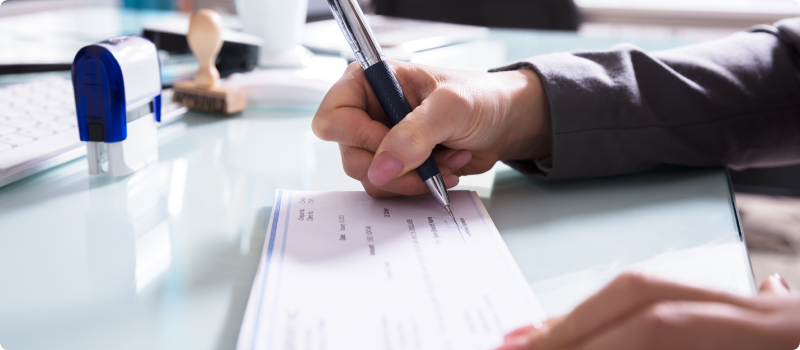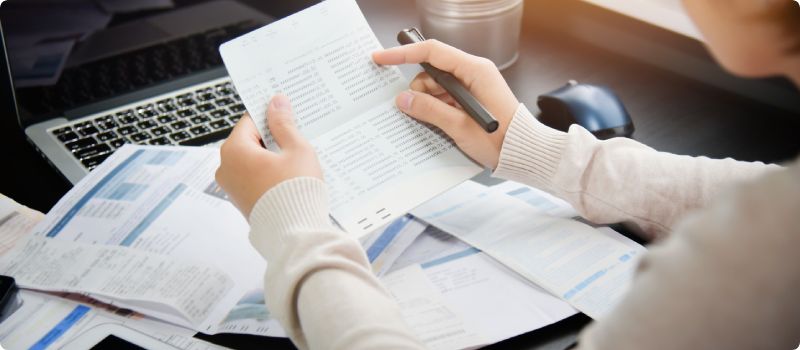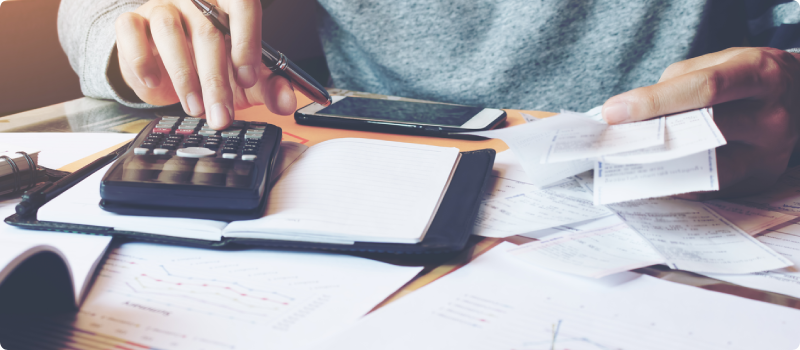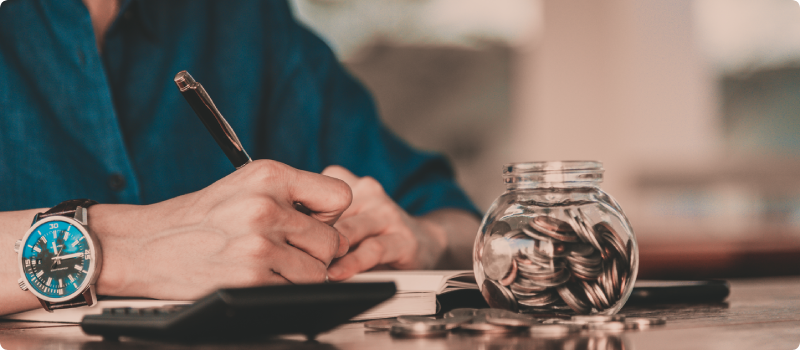Preventing Check Fraud
Updated May 14, 2024 . AmFam Team
Check fraud is one of the biggest challenges facing the nation's financial system. Through the use of computer technology and basic resourcefulness, criminals, either independently or in organized gangs, are finding it increasingly easy to manipulate checks in such a way as to defraud consumers and businesses. While both consumers and businesses may suffer financial loss from check fraud, consumers also face the inconvenience and anxiety caused by resolving problems with their banks and local merchants, as well as possible repercussions with credit bureaus.
We’ve highlighted some key information on what businesses and consumers can do to prevent becoming the victim of check fraud.
Types of Check Fraud Schemes
Fraud schemes involving checks take many forms. Checks may be:
- Altered, either as to the payee or the amount
- Counterfeited
- Forged, either as to signature or endorsement
- Drawn on closed accounts
- Used in a variety of schemes
Check fraud criminals may be insiders, independent operators, or organized gangs. The methods they use to further check fraud include:
- Getting customer information from insiders
- Stealing bank statements and checks
- Working with dishonest employees of merchants who accept payments by check
- Rifling through trash for information about bank relationships

What is an altered check?
Altered checks are a common fraud that occurs after a legitimate maker creates a valid check to pay a debt. A criminal then takes the good check and uses chemicals or other means to erase or change the amount or the name of the payee so that new information can be entered. The new information can be added by typewriter, in handwriting, or with a laser printer or check imprinter, whichever seems most appropriate to the check.
What are counterfeit checks?
Counterfeit checks are presented based on fraudulent identification or are false checks drawn on valid accounts.
Example 1: A group of criminals open checking accounts, cash counterfeit checks, and file false tax returns using fraudulent drivers' licenses, social security cards, and other identification. They use information from individual and corporate garbage as the basis for producing the identification with computer technology.
Example 2: A bank insider identifies corporate accounts that maintain large balances, steals genuine corporate checks, counterfeits them, and returns the valid checks to the bank. The bank insider is associated with a group of criminals that distributes the counterfeit checks throughout the area and cashes them using fictitious accounts.
What is identity assumption?
Identity assumption in check fraud occurs when criminals learn information about a bank customer, such as name, address, bank account number, account balance, social security number, home and work telephone numbers, or employer, and use the information to misrepresent themselves as the valid bank customer. These schemes may involve changing account information, creating fictitious transactions between unsuspecting parties, or preparing checks drawn on the valid account that are presented using false identification.
Example 1: A bank customer pays a bill in the normal course of business. An employee of the payee then copies the check and provides it to a partner in crime who contacts the bank and, using information from the check, pretends to be the account holder. The criminal tells the bank that he or she has moved and needs new checks sent to the new address as quickly as possible. When the bank complies, the forged checks are written against the customer's account.
Example 2: A criminal uses customer information, sometimes from a bank insider, to order checks from a check printer, or to create counterfeit checks and false identification. The criminal then writes fraudulent checks and presents them for deposit into the customer's account, requesting part of the deposit back in cash. The cash-out from the transaction represents the proceeds of the crime.

What is closed account fraud?
Closed account frauds are based on checks being written against closed accounts. This type of fraud generally relies upon the float time involved in inter-bank transactions.
Example 1: A fraud ring provides "role players" with business checks drawn on closed accounts at a bank. The "role players" then deposit the checks into a new account at a different bank through one or more ATMs operated by other banks. The float time between the ATM deposits and the checks drawn on the closed accounts reaching the issuing bank for payment allows the criminals to withdraw funds from the new account.
What is new account fraud?
A significant amount of check fraud involves new accounts, both personal and corporate, opened by criminals with the express intent of defrauding the bank.
Example 1: A criminal opens a new account using false employment information and incorrect addresses and telephone numbers. After conducting some small transactions or otherwise gaining information on the bank's procedures for posting checks and ATM transactions and the type of identification required to cash checks, the criminal deposits bogus or stolen checks into the account and makes substantial withdrawals before the bank realizes it has been victimized.
Example 2: A criminal opens a corporate account using a fictitious company name and soon deposits a large amount in counterfeit checks into the account. After inflating the account with the counterfeit checks over a short period, the criminal then asks the bank to prepare cashier's checks for a large proportion of the account balance. Because the cashier's checks are reliable, they are easily converted to cash.

What is fraud by bank insiders?
Often check frauds depend on information provided by bank insiders. In addition to schemes discussed elsewhere, which may involve access to information about one account or relationship, frauds based on insider knowledge are often broader because they are based on knowledge of the bank's operations and access to many accounts.
Example 1: A former bank employee obtains legitimate bank account numbers and uses the numbers with fictitious corporate names to order company payroll checks. He and several cohorts then use false identification to open bank accounts and cash the checks.
What is telemarketing fraud?
Telemarketing frauds are based on the creation of "demand drafts," rather than checks. A demand draft resembles a personal check but carries no signature. In place of a signature, it has a notice that the account holder has given permission to have money withdrawn from his or her checking account to pay bills for goods and services.
Example 1: The criminal calls a consumer and announces that the consumer has won a cash prize. The criminal explains that, to deposit the prize into the "winner's" account, he or she needs the account information. Once the consumer provides the account information, the criminal prepares demand drafts and withdraws funds from the account. (A common variant is for the criminal to offer the consumer something for sale, such as a magazine subscription, in order to get the necessary account information.)
Example 2: A representative of a criminal organization contacts potential credit card users and promises to arrange for them to get credit cards. The representative asks for checking account information to issue the card and, when the information is provided, prepares demand drafts against the consumers' accounts.
What is check fraud by gangs?
Some gangs have become actively involved in check fraud. These gangs typically go after corporate accounts and have received a measure of notoriety because of their successes and failures.
Example 1: Gangs have traveled throughout the country cashing counterfeit payroll checks obtained by gang members in targeted corporations or financial institutions. They use sophisticated counterfeiting techniques to capture the company's logo and a company executive's signature by scanning them and to prepare payroll checks using account information from a company check or a bank insider. They use the same information and techniques to prepare false identification for the people who will cash the checks.
If insider information is not available, such gangs sometimes call the targeted company's accounts receivable department, tell them that they have funds to wire into the company's account, and get the company's bank account number to accomplish the transfer. The deposit, of course, never materializes.
Such gangs move into a city or town around payday and cash the checks at local institutions that have check cashing agreements with the targeted corporation.
Example 2: A fictitious foreign company sends a letter to an individual or U.S. company claiming to have a large quantity of money that must be transferred out of the foreign home country immediately. The foreign company asks the targeted individual or company to help set up a bank account into which the money can be transferred. They offer a sizable commission, while asking for the target's checking account information. The foreign company's representative then uses the account information to withdraw money from the target's checking account using bank drafts.

How to Identify Fraudulent Checks
There are several warning signs that may indicate a bad check. While one sign on its own does not guarantee a check to be counterfeit, the greater the number of signs, the greater the possibility that the check is bad. Some common warning signs include:
- A check that does not have a Magnetic Ink Character Recognition (MICR) line (i.e., numbers at the bottom of a check, printed in magnetic ink, that can be read by machine and which provide information, in code, about the name and address of the drawee bank, account number, and check number).
- A routing code in the MICR line that does not match the address of the drawee bank.
- MICR ink that looks shiny or that feels raised. Magnetic ink is dull and legitimate check printing produces characters that are flat on the paper.
- A check on which the name and address of the drawee bank is typed rather than printed, or that includes spelling errors.
- A check that does not have a printed drawer name and address.
- A personal check that has no perforated edge.
- A check that shows indications of information having been altered, eradicated, or erased.
- A check drawn on a new account that has no (or a low) sequence number or a high dollar amount.
- A signature that is irregular-looking or shaky or shows gaps in odd spots.
- A check printed on poor quality paper that feels slippery.
- Check colors that smear when rubbed with a moist finger. (This suggests they were prepared on a color copier.)
- Checks payable to a corporation that are presented for cashing by an individual.
- Corporate or government checks that show numbers, which do not match in print style or otherwise suggest that the amount may have been increased.
- Checks presented at busy times by belligerent or distracting, fast-talking customers who try to bypass procedures.
- Checks that have dollar amounts in numbers and in words that do not match.
- Items that are marked "void" or "nonnegotiable," yet are presented for cash or deposit.
Fraud Prevention Measures
In order to prevent fraud, banks and retail businesses have instituted various procedures and developed a variety of safeguards. These include:
Positive pay. Positive pay allows a company and its bank to work together to detect check fraud by identifying items presented for payment that the company did not issue. In the usual case, the company electronically transmits to the bank a list of all checks it issued on a particular day. The bank verifies checks received for payment against that list and pays only those on the list. The bank rejects:
- Checks not on the company's list
- Checks that exceed a specific dollar amount
- Checks that carry dates long past (stale checks)
The bank investigates rejected checks to find out if the items are fraudulent or in error. The bank only pays exception items approved by the company.
Reverse positive pay. Reverse positive pay is similar to positive pay, but the process is reversed, with the company, not the bank, maintaining the list of checks issued. When checks are presented for payment and clear through the Federal Reserve System, the Federal Reserve prepares a file of the checks' account numbers, serial numbers, and dollar amounts and sends the file to the bank.
In reverse positive pay, the bank sends that file to the company, and the company compares the information to its internal records. The company lets the bank know which checks match its internal information, and the bank pays those items. The bank then researches the checks that do not match, corrects any misreads or encoding errors, and determines if any items are fraudulent. The bank pays only "true" exceptions (i.e., those that can be reconciled with the company's files).
Fingerprints. Some banks (and other businesses) have seen a reduction in check fraud by fingerprinting non-customers that seek to cash checks. Generally, the programs require all persons presenting checks for payment, who do not have an account with the bank (i.e., non-customers), to provide a thumbprint.
The teller explains the process whenever a non-customer presents a check for payment. The teller will not accept the item if the person objects. A person who does not object to providing a fingerprint is asked to ink his or her thumb on a small pad and place the imprint in the space between the memo line and signature line of the check being presented. If the bank later finds out the check was fraudulent or was altered, it can provide the check, with the fingerprint, to law enforcement officials.
Any business that implements this type of plan should exercise care to ensure that it is not applied on a selective basis.
Check 21. To make check processing faster, many banks no longer send paper checks to other banks to receive payment. Instead, these banks exchange payment information electronically. A federal law, the Check Clearing for the 21st Century Act (Check 21), which was signed into law on October 28, 2003 and became effective on October 28, 2004, makes it easier for banks to electronically transfer check images instead of physically transferring paper checks. Check 21 permits banks to replace original checks with "substitute checks." Substitute checks are special paper copies of the front and back of the original check. They can be processed as if they were original checks.
Check 21 speeds up processing, controls costs, and reduces fraud by providing early notification of return items.
Data sharing. In 1993, the American Bankers Association and the National Retail Federation sponsored an inter-industry task force, known as the Bank Check Fraud Task Force, to examine solutions to check fraud problems. The Task Force has developed a data sharing program for closed accounts. This program prevents people who have outstanding checks due to retailers from opening new accounts.
Participating financial institutions report all checking accounts closed for cause to a central database called ChexSystems. ChexSystems transmits the closed account information to the shared check authorization network (SCAN) database. Participating banks use the SCAN information before opening new accounts to spot repeat offenders. A participating bank also can use MICR information from a check presented with the applicant's drivers’ license number to check the SCAN file for any previous bad account activity.

Check Security Features
Check manufacturers help deter check fraud by making checks difficult to copy, alter, or counterfeit. Some useful security measures include:
Watermarks. Watermarks are made by applying different degrees of pressure during the paper manufacturing process. Most watermarks make subtle designs on the front and back of the checks. These marks are not easily visible and can only be seen when they are held up to light at a 45-degree angle. This offers protection from counterfeiting because copiers and scanners generally cannot accurately copy watermarks.
Copy void pantograph. Pantographs are patented designs in the background pattern of checks. When photocopied, the pattern changes and the word "VOID" appears, making the copy nonnegotiable.
Chemical voids. Chemical voids involve treating check paper in a manner that is not detectable until eradicator chemicals contact the paper. When chemicals are applied, the treatment causes the word "VOID" to appear, making the item nonnegotiable. Checks treated with chemical voids cannot be altered without detection.
High-resolution microprinting. High-resolution microprinting is very small printing, typically used for the signature line of a check or around the border in what appears to be a line or pattern to the naked eye. When magnified, the line or pattern contains a series of words that run together or become totally illegible if the check has been photocopied or scanned with a desktop scanner.
Three-dimensional reflective holostripe. A holostripe is a metallic stripe that contains one or more holograms, similar to those on credit cards. These items are difficult to forge, scan, or reproduce because they are produced by a sophisticated laser-based etching process.
Security inks. Security inks react with common eradication chemicals. These inks reduce a forger's ability to modify the printed dollar amount or alter the designated payee because when solvents are applied, a chemical reaction with the security ink distorts the appearance of the check. This makes such items very difficult to alter without detection.
Check Fraud Prevention Tips for Businesses
In order to prevent check fraud, businesses need to consider both their internal and external procedures.
Internal Procedures
- Review bank statements regularly in order to check for any irregularities.
- Make sure that the authorized signers of company checks are not the same people who reconcile the account.
- Review all hiring procedures — know your employees.
- Make sure two people are responsible for accounts payable.
- Make sure that mailroom personnel and procedures are sound.
- Keep all check stock or cash equivalents in a secure and locked facility.
- Change keys or entry codes periodically to prevent routine access to storage areas.
- Consider surprise audits.
- Consider moving check disbursement activity to electronic payment.
- Read and understand your bank contracts regarding liability for fraud under the Uniform Commercial Code.
External Procedures
- Maintain contact with other businesses in your area so you can receive timely information on fraud occurrences. Keep a record of when, what, and how a fraud may have hurt your business so you can prevent it the next time.
- Use bank services like positive pay, expedited return information, and signature verification systems to protect your accounts' payables and accounts’ receivables.
- Purchase check stock from well-established vendors. Use safety paper. If you process your accounts payables through a service bureau, make sure you have a copy of its security procedures.
- Reconcile your check disbursements and deposits regularly.
- If a payment account is fraudulently used, close the account as soon as possible.
- Be cautious when using refund accounts, such as rebates for subscriptions. This is another target for check fraud. The checks are relatively easy to obtain and can be used for counterfeits.
- Evaluate the use of negative check file databases, especially if you accept a large number of payments by check.
- Find ways to replace paper documents with electronic payment devices.
Additional Tips for Retail Businesses
- Require two forms of identification for all payments by check, and list them on the back of the check.
- Do not accept third-party checks, such as payroll or government checks, since these may be stolen.
- Consider the use of electronic check verification services, especially if you accept a large number of payments by check.
- Know your customers.

Check Fraud Prevention Tips for the Consumer
Criminals today can defraud consumers quite easily with a blank check taken from their check book, a canceled check found in their garbage, or a check mailed to pay a bill. Therefore, it is important that consumers follow a common-sense, logical approach with the way they use and store their checks.
- Do not give your checking account number to people you don't know, even if they claim they are from your bank.
- Reveal checking account information only to businesses you know to be reputable.
- Report any inquiries or suspicious behavior to your bank who will take measures to protect your account and notify proper authorities.
- Do not leave your automated teller machine receipt at the ATM; it contains account information.
- Use direct deposit.
- Report lost or stolen checks immediately.
- Store your checks, deposit slips, bank statements, and canceled checks in a secure and locked location. Never leave your checkbook in your vehicle or in the open.
- Reconcile your bank statement within 30 days of receipt in order to detect any irregularities; otherwise, you may become liable for any losses due to check fraud.
- Properly store or dispose of canceled checks. Unless needed for tax purpose, destroy old canceled checks, account statements, deposit tickets, and ATM receipts. The personal information on them may help someone impersonate you.
- Guard new checks. When you receive your check order, make sure all of the checks are there, and that none are missing. Report missing checks to your bank at once. Should you fail to receive your order by mail, alert your bank. Checks could have been stolen from a mail box or lost in transient.
- If your home is burglarized, check your supply of checks to determine if any have been stolen. Look closely, because thieves will sometimes take only one or two checks from the middle or back of the book. The longer it takes to detect that any of your checks have been taken, the more time the criminal has to use them successfully.
- If someone pays you with a cashier's check, have him/her accompany you to the bank to cash it. If at all possible, only accept a check during normal business hours so you can verify whether it is legitimate. Make sure you obtain identification information from the individual.
- Do not mail bills from your mailbox at night. It is a favorite location from which a criminal can gain possession of your check with the intent to defraud you. Criminals will remove a check from your mailbox and either endorse it using bogus identification, photocopy and cash it repeatedly, scan and alter the check, or chemically alter it. The Post Office is the best location from which to send your bill payment.
- Limit the amount of personal information on your check. For example, do not include your Social Security, driver's license, or telephone numbers on your check. A criminal can use this information to literally steal your identity by applying for a credit card or loan in your name, or even open a new checking account.
- Do not leave blank spaces on the payee and amount lines.
- Use dark ink that can't be easily erased or covered over.
- Do not write your credit card number on the check.
- Use your own pre-printed deposit slips, and make sure the account number on your slip is correct. Thieves occasionally alter deposit slips in the hope you won't notice and the money goes into their account.
- Do not make a check payable to cash. If lost or stolen, the check can be cashed by anyone.
- Never endorse a check until you are ready to cash or deposit it. The information can be altered if it is lost or stolen.
How To Protect Incoming Mail from Check Fraud
- Lock your mailbox. If your postal carrier is willing, you can buy a padlock for your mailbox. Place it unlocked inside your mailbox. When the carrier delivers your mail, he or she locks the box. This works well with rural-delivery style boxes with a hole to accommodate a lock, or you can drill holes in a wall-mounted box. The method is not foolproof, however. Persistent thieves have been known to use hacksaws to remove locks; some smash open mailboxes with baseball bats - or even steal the mailbox, lock and all.
- Replace a wall-mounted mailbox with a mail slot. If you have door-to-door delivery, ask your local Post Office if you can replace your mailbox with a mail slot on your front or garage door. The postmaster needs to approve any changes in delivery. If you add a mail slot, make it large enough to accommodate catalogs and boxes of checks. Mail slots are not allowed, however, in rural delivery areas or newer neighborhoods with cluster boxes.
- Buy a security mailbox. Check the yellow pages under "mailboxes" for listings of companies that sell tamper-resistant mailboxes. Heavy-duty metal boxes are available in both wall-mounted and free-standing models (the latter may be sunk in concrete to prevent vandalism.) Security mailboxes typically have a slot for the carrier to deliver mail. Mail goes down a chute and into a locked compartment.
- Ask your apartment manager to improve security. If you're a renter and your mailbox lock doesn't work, insist that the management repair the damage. Counterfeit keys are another problem in rental communities, since often the same key opens all the boxes. Managers can counter these problems by installing security cameras or moving mailboxes into a mail room where residents must use an access key to get inside.
- Get a post office box. If theft is a concern, the cost of renting a post office box may be worth the investment, since thefts from such boxes are rare, according to postal authorities.
- Consider a parcel locker. If you own a home-based business and receive frequent shipments of valuable goods, you may wish to invest in a parcel locker. If you use multiple delivery services, however, you'll need one for postal deliveries and a separate locker for the delivery service.
- Pick up mail promptly. Mail thieves often follow carriers on their routes, striking within 15 minutes after delivery. If you're home during the day, pick up mail as soon after delivery as possible. If you're not home, ask a trusted neighbor to get your mail.
- Keep your mailbox visible. Trim shrubbery to keep your mailbox as visible as possible, eliminating hiding places for thieves.
How To Protect Outgoing Mail from Check Fraud
- Do not leave outgoing mail in your mailbox. That little red flag is an invitation to thieves. Take outgoing mail to your office, or mail it at a post office or mailing outlet store.
- Do not mail holiday gifts from home. They will not only steal your package, they will peel off the stamps and use those, too.
- Do not put mail in street mailboxes. The highest rate of mail theft locally is from those big, blue Postal Service mailboxes located on street corners and at other public places.
- Send valuables via registered mail. Registered mail is kept under lock and key, and it is signed for every time it changes processing centers.
Checks can be stolen, manipulated, or counterfeited. Illicitly obtained checks can be negotiated immediately, altered, or used for future counterfeiting. Generally, only unsophisticated criminals acting alone will immediately negotiate stolen checks by forging the signature. Most organized groups steal checks as a prelude to more enterprising endeavors.
Security and law enforcement officials agree that the problems associated with check fraud and counterfeit negotiable instruments have reached epidemic proportions. As criminal organizations become more sophisticated in the devices they use, businesses and consumers must be more alert to this growing problem and the prevention tools available.
Head to our loss control and risk management page to learn more ways to protect your business.
This article is for informational purposes only and based on information that is widely available. We do not make any guarantees or promise any results based on this information. This information does not, and is not intended to, constitute legal or financial advice. You should contact a professional for advice specific to your situation.
Tools & Resources
NextScripts
JSS component is missing React implementation. See the developer console for more information.

